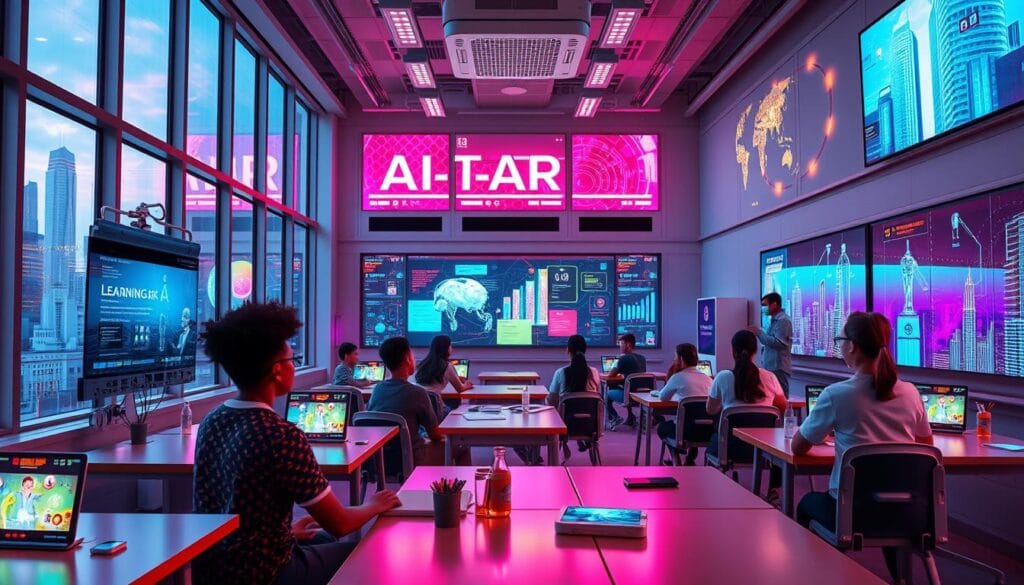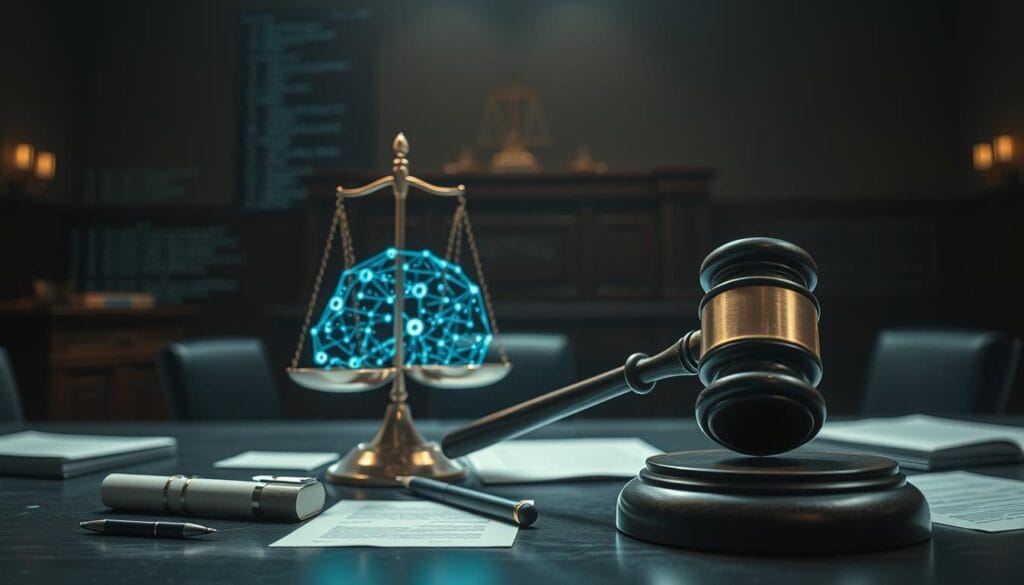“The greatest peril of artificial intelligence is that people conclude too early that they understand it.” – Eliezer Yudkowsky. This statement is especially relevant in academic settings, where AI tools like ChatGPT introduce new challenges. Institutions dedicated to academic integrity must navigate these changes. Questions about Turnitin’s ability to identify AI-generated content are common. Reports suggest Turnitin can detect ChatGPT outputs, sparking interest in how these systems operate and their impact on academic honesty. It’s noted that Turnitin can flag AI-generated text, assigning a similarity score that indicates its presence in student submissions12
As educational institutions increasingly use Turnitin—a tool used by over 15,000 organizations for plagiarism detection2—understanding its detection mechanisms is vital. This article explores whether Turnitin can reliably distinguish between original work and ChatGPT-generated text. It examines Turnitin’s AI detection capabilities and their implications for students and educators.
Key Takeaways
- Turnitin has developed a machine learning model to detect ChatGPT-generated submissions.
- Text samples need to be at least 300 words for Turnitin’s AI detection to be effective.
- Turnitin’s AI detection scores help identify unoriginal content and evaluate potential plagiarism.
- Relying exclusively on AI-generated text carries real academic risks, as Turnitin often flags suspicious content.
- Educational institutions must stay informed on the capabilities and limitations of AI detection tools.
Understanding Turnitin’s Plagiarism Detection Mechanism
The Turnitin plagiarism checker is a crucial tool for upholding academic integrity worldwide. It employs sophisticated algorithms, combining machine learning and natural language processing. These tools analyze text for similarities. When a document is uploaded, Turnitin generates a similarity report, showing matched text and the work’s originality percentage.
How Turnitin Works
Turnitin breaks down content into sections, examining each sentence in context. This method helps identify similarities with past submissions and published works. Its detection rate is impressive, at 98%, making it more effective against traditional plagiarism than AI-generated content3.
Types of Content Analyzed
Turnitin can check various written materials, including essays, research papers, and reports. Its vast database helps spot academic dishonesty. However, it struggles with AI-generated content, like that from ChatGPT, due to its originality and human-like writing4.
Limitations of the System
Turnitin’s ability to detect AI-generated content is currently restricted. The uniqueness, quality, and context of the text impact its detection rate. As AI writing improves, educators find it harder to distinguish it from student work, raising concerns about academic honesty4. Turnitin may need to refine its algorithms to better identify AI-generated text4.
What is ChatGPT and Its Applications?

ChatGPT is a leading-edge generative AI tool that crafts human-like text from user inputs. It enables a variety of ChatGPT applications across different sectors, notably in education for essay writing and research aid. However, its growing popularity also brings up ethical dilemmas in educational settings.
Overview of ChatGPT
OpenAI developed ChatGPT, which excels in producing coherent, contextually relevant text. Its algorithm simulates human conversation, making it appealing for both students and educators. It’s crucial for educators to grasp how ChatGPT can alter learning environments and ponder its widespread implications.
Uses in Educational Settings
In schools, ChatGPT acts as a supplementary tool, helping students improve their writing and grasp complex topics. It’s vital to use AI content detection technology to uphold academic integrity. Yet, students should leverage these tools to enhance their learning, not replace it. Educators see the benefits but emphasize the need for originality and critical thinking in student work.
Ethical Considerations
The rapid rise in AI use sparks a debate on its ethical use in education. Concerns include academic dishonesty, the authenticity of student work, and AI-generated content overuse. It’s vital for students to balance AI assistance with ensuring their work showcases their own understanding and skills.
The Relationship Between Turnitin and AI-generated Texts
Understanding the relationship between Turnitin and AI-generated content is vital for educators and students. With the rise of AI tools like ChatGPT, the need for effective detection methods is growing. Turnitin has updated its detection capabilities to combat these challenges, ensuring academic integrity.
Detection Techniques for AI Content
Turnitin uses advanced algorithms to identify AI-generated text patterns, offering insights into originality. It can detect AI content with up to 98% accuracy5. The AI writing indicator scores submissions from 0% to 100%, though achieving full accuracy is hard due to false positives5.
Challenges in Identifying AI-generated Work
The advent of AI tools has brought significant challenges to content detection. About 59% of students have used AI tools like ChatGPT, highlighting AI’s growing role in education6. The task of identifying AI-generated work is complicated by AI’s ability to mimic human writing. This makes it hard for schools to ensure the authenticity of student work, with over 9.9 million papers flagged for AI content6. Educators must find ways to distinguish between genuine student work and AI-generated content.
Current Research on AI Detection Tools

The field of AI detection tools is evolving swiftly. Educators and institutions must adapt to the rapid progress in AI content detection technology. Turnitin has recently emphasized the importance of academic integrity, given the rise in AI tool usage.
Recent Developments in AI Detection
Turnitin has introduced an enhanced AI detection tool, boasting a 98% accuracy rate in identifying AI-generated content7. However, research indicates that up to 15% of AI-generated text might evade detection8. The integration of AI detection into plagiarism tools is becoming more prevalent, especially with nearly half of college students regularly using generative AI tools7. This development sparks debates on the tools’ effectiveness and trustworthiness.
Comparisons with Traditional Tools
New AI detection tools focus on writing patterns and characteristics unique to machine-generated text8. Turnitin claims a false positive rate under 1% for documents likely to contain AI content9. Yet, studies show that about 22% of college students admit to using AI tools for their assignments7. This contrast highlights the hurdles posed by changing student behaviors and the technological solutions being developed to counter these challenges.
User Experiences with Turnitin and ChatGPT
Insights from user experiences with Turnitin and ChatGPT in education show stark differences between students and instructors. Students worry about Turnitin’s strict detection, fearing AI flags. In contrast, instructors value it for upholding academic integrity. They note Turnitin’s limitations in detecting AI in short texts, with a false negative rate up to 65%1011.
Student Perspectives
Students often feel anxious when using Turnitin. They fear being accused of academic misconduct for using tools like ChatGPT. Tutors and professors may reject assignments if AI is detected, causing more stress. This situation creates mistrust, affecting students’ learning and questioning the role of technology in education11.
Instructor Feedback
Instructors see Turnitin as essential for maintaining educational standards. They stress the need for clear guidelines on AI usage. Despite Turnitin’s ability to score AI detection from 0% to 100%, some students manage to use AI without clear evidence in their work5. The system’s improvement in detecting AI is a step towards a more honest academic environment10.
The Impact of ChatGPT on Academic Integrity

The integration of ChatGPT into academic environments poses significant academic integrity challenges for institutions. The rise of AI-generated texts has heightened concerns over plagiarism and academic dishonesty. Students using ChatGPT risk facing ChatGPT consequences, including severe penalties for unauthorized collaboration or plagiarism.
Potential Consequences for Students
Students using AI tools like ChatGPT may find themselves caught in academic misconduct. A study revealed that professors at two US universities found ChatGPT could pass law and business exams, sparking fairness concerns12. This could result in severe disciplinary actions, including failing grades and penalties under institutional academic policies. The University of Sydney has classified AI-generated content as cheating, highlighting the severity of these issues12.
Institutional Responses
Education institutions are swiftly developing institutional academic policies to address AI tool challenges. Many advocate for reassessing evaluation methods, as plagiarism detection software often fails to identify AI-generated content13. Implementing proctoring software and reverting to traditional assignment formats are seen as effective solutions to uphold academic integrity13. Institutions are also promoting open discussions with students about AI tool risks, emphasizing the value of ethical writing practices14.
Strategies to Avoid Detection by Turnitin

Students are under immense pressure to create original content, all while understanding the capabilities of tools like Turnitin. To avoid detection, they can employ various strategies that enhance their academic writing. By focusing on originality, students can express their creativity while meeting academic standards. Adopting a unique writing style is also key to avoiding detection.
Writing Original Content
Authentic work is essential for maintaining academic integrity. Students should use different methods to writing original content, such as conducting thorough research and adding personal insights. While AI tools can help in drafting, it’s important to revise carefully to ensure the work is genuine.
Best Practices for Academic Writing
Effective communication through academic writing strategies is critical. Proper citation is crucial for acknowledging sources, which helps avoid plagiarism. Tools like Grammarly can refine language but should be used with caution, as they might alter sentence structures and trigger Turnitin’s detection system15.
Techniques such as manually paraphrasing flagged content and using services like Coursepivot.com can help avoid Turnitin detection15. It’s recommended to remove repetitive phrases and common AI language to make the text more relatable16.
Educational Institutions’ Stance on AI Tools

AI technology is increasingly shaping the educational landscape, creating a complex dynamic between educational institutions and AI. Universities are now grappling with the integration of AI tools to improve teaching and learning. They face the challenge of balancing the benefits of AI with potential drawbacks. Many believe that the ability to use generative AI tools is crucial for students’ professional success. A recent study found that over 50% of educators strongly agree with this viewpoint17.
The adoption of generative AI tools among faculty members has surged, from 9% to 22% between March and September 202317.
Views from Universities
Universities are updating their policies to address the growing presence of AI in higher education. For instance, Vanderbilt University and the University of Pittsburgh have temporarily disabled Turnitin’s AI detection tool due to concerns over bias and false positives18. The Center for Teaching Excellence at the University of Kansas advocates for a comprehensive approach to detecting AI misuse. They suggest combining style and content analysis with automated tools18.
Moreover, 81% of respondents believe that educators should employ technology to identify AI-generated work19.
Policy Developments
Universities are recognizing the necessity to revise their university policies on AI tools to uphold academic integrity. They are promoting a blend of AI detection tools and human evaluation to ensure fairness in grading. The introduction of new detection features, such as those by Turnitin, aims to achieve 98% accuracy in identifying AI usage19.
However, the risk of false positives remains a contentious issue, leading to a reevaluation of technology implementation18. As policies evolve, the aim is to create an environment that leverages AI’s benefits while maintaining core educational values.
The Future of AI in Education

The integration of AI in education is rapidly advancing, showing significant trends in AI adoption by students and educators. Generative AI tools are becoming more prevalent, with students increasingly relying on them. Statistics reveal that 59 percent of students have used AI tools like ChatGPT monthly since its release in November 2022. This marks a shift in educational approaches6. Moreover, nearly one in three college students have used ChatGPT for essay writing20.
Trends in AI Usage
Classrooms are embracing these new technologies, with AI tool acceptance on the rise. Over 60 percent of students using ChatGPT apply it frequently, showcasing its crucial role in education20. This trend points to a shift toward integrating AI into learning models, fostering collaboration between teachers and technology.
Predictions on Plagiarism Detection
The future of plagiarism detection technology looks promising, with advancements expected to be more targeted. Since Turnitin’s AI writing detection tool launched in April 2023, it has reviewed over 250 million submissions. Notably, 8.4 million submissions showed over 80 percent AI involvement9. As AI-generated content grows, plagiarism detection algorithms will evolve, emphasizing the importance of academic integrity20. Turnitin’s achievement of a 98 percent detection rate highlights the progress in this field20.
How to Use ChatGPT Responsibly

The advent of AI tools like ChatGPT necessitates a shift in how students and educators approach academic work. It’s crucial to understand the guidelines for ethical use of these technologies. This means learning to use AI-generated content responsibly, ensuring academic integrity and enriching the learning process. The key is to integrate these tools into our research and writing without undermining original authorship.
Guidelines for Ethical Use
Students should view ChatGPT as a helpful tool for homework and research, not a substitute for their own work. A significant 89% of users rely on ChatGPT for homework and tests, showcasing its widespread appeal21. It’s vital to acknowledge any AI-generated content to maintain academic integrity. Educational giants like Harvard University encourage responsible use of generative AI, advising students to consult with instructors before using these tools in academic settings21.
Incorporating AI into Research
Integrating AI into research requires setting clear ethical standards. Turnitin’s AI detection tool is designed to analyze content over 300 words, focusing on the GPT family of models22. As Turnitin’s detection capabilities improve, students must hone their critical thinking and writing skills. Institutions like the University of Missouri allow ChatGPT use with professor consent, fostering a balanced approach to technology in education21.
Legal Implications of AI-generated Text

The emergence of AI-generated content has brought forth substantial legal issues of AI content for educators and students to address. Grasping the concept of copyright in AI-generated text is essential, given the lag in traditional laws adapting to new technologies. The debate over ownership and rights in AI content generation tools is ongoing.
Copyright Considerations
Copyright law, designed to protect original works, faces hurdles when applied to AI-generated text. For example, Turnitin’s analysis showed that 11% of the 200 million papers reviewed contained at least 20% AI writing. Moreover, 3% had over 80% AI involvement23. This complexity underscores the challenges in defining authorship and ownership in AI-assisted content, as traditional copyright laws may not fully address these issues.
Intellectual Property Rights
In the realm of education, intellectual property rights are paramount for protecting the creations of both students and educators. The growing use of AI tools raises critical questions about attribution and authenticity. A study found that only three out of 16 AI detection software programs were highly accurate in identifying GPT-4 papers23. This indicates that many submissions might not be properly checked. Additionally, the legal implications of content created by AI models like ChatGPT are still unclear, as current laws struggle to adapt to these technologies’ complexities.
Turnitin’s Future Updates and AI Adaptation

Turnitin is dedicated to improving its AI detection capabilities. The platform is set to introduce Turnitin updates aimed at enhancing AI detection. These updates will provide educators with better tools to ensure academic integrity. Recent developments show Turnitin’s AI detection can spot AI-generated content, like ChatGPT, with 98% accuracy24. This marks a significant advancement in the Future of Turnitin technology, enabling more precise evaluation of student work.
Expected Enhancements to Detection
Turnitin is set to enhance its AI detection model using real-world data. This will boost the accuracy of its assessments25. The model currently identifies content from GPT-3 and GPT-3.5, including ChatGPT, ensuring educators have reliable detection tools26. With over 16,000 institutions worldwide as its partners, Turnitin is integrating AI detection into platforms like Turnitin Feedback Studio and Originality Check+. This signals a thorough strategy to uphold academic standards25.
Turnitin’s Response to AI Technology
Turnitin’s development team, led by former educators, takes a positive stance on AI writing tools. They suggest using these tools constructively rather than banning them24. The goal is to enhance detection while giving educators the tools to gauge AI’s role in submissions. These updates reflect Turnitin’s commitment to academic integrity while embracing modern technology25.
Creating a Culture of Academic Honesty

Building a culture of academic honesty in schools is key to upholding student integrity. By adopting academic honesty practices, educators can motivate students to strive for excellence in their academic work. This is done through various educator strategies for integrity that foster original ideas and proper citation. Research by McCabe, Butterfield, and Treviño shows that an institution’s academic culture greatly impacts student dishonesty27. Thus, setting up honor codes and robust academic integrity programs is crucial in molding student behavior and fostering ethical conduct27.
Best Practices for Educators
Educators are pivotal in instilling integrity in students. By using Turnitin’s tools, like Turnitin Originality and Draft Coach, educators can verify the authenticity of student work and make informed decisions on academic integrity27. Moreover, Turnitin’s Disrupting Plagiarism resource pack provides more than 20 teaching tools for educators to tackle academic integrity issues proactively27. Clear academic expectations empower students to take responsibility for their learning.
Supporting Students in Ethical Writing
Supporting students in ethical writing is crucial, especially with the rise of AI-assisted writing. Engaging students in reflective exercises, such as mid-work check-ins and post-assignment reflections, helps them critically assess their work and grasp the value of originality28. Lessons on research strategies and Turnitin Similarity Reports interpretation can also aid students in honing their writing skills and upholding integrity28. Comprehensive support from educators can create an environment that values integrity and academic standards.
Conclusion: The Intersection of AI and Academic Integrity
The integration of AI, such as ChatGPT, into academic settings brings both opportunities and challenges. ChatGPT quickly gained 100 million active users, faster than TikTok and Instagram29. This rapid growth highlights the interest in AI for education. However, it also emphasizes the need to protect academic integrity, as 76% of teachers see ChatGPT’s role in schools as crucial for the future29.
Summary of Key Points
Despite its popularity, 80% of students view ChatGPT as cheating, raising concerns about academic dishonesty29. AI tools can improve research efficiency but must overcome biases, hallucinations, and inaccuracies30. Turnitin, a plagiarism detection tool, has adapted to identify AI-generated texts, showing the ongoing fight against technology and academic integrity31.
Future Directions for Education and Technology
As schools embrace tools like ChatGPT, discussing integrity challenges and solutions is vital. The future of education technology must develop ethical AI use while protecting learning integrity30. A balanced approach is necessary, promoting innovation while upholding values. This will be key for educators, students, and tech developers.
FAQ
Does Turnitin detect ChatGPT-generated content?
What mechanisms does Turnitin use for plagiarism detection?
What types of content can Turnitin analyze?
What are some limitations of Turnitin’s detection system?
How is ChatGPT applied in educational settings?
What ethical concerns arise with the use of ChatGPT?
What techniques does Turnitin employ to detect AI-generated texts?
What challenges does Turnitin face in identifying AI-generated work?
How have recent developments in AI detection tools impacted academia?
How do students perceive the use of Turnitin and ChatGPT?
What are the potential consequences for students using ChatGPT?
What strategies can students employ to avoid detection by Turnitin?
How are educational institutions responding to AI tools like ChatGPT?
What are the future trends of AI in education?
How can ChatGPT be used responsibly in educational contexts?
What legal implications should students be aware of regarding AI-generated text?
What updates can be expected from Turnitin in response to AI technologies?
How can educators foster a culture of academic honesty?
Source Links
- Can Turnitin detect text from ChatGPT?
- Can Turnitin Detect ChatGPT? 2024 Turnitin ChatGPT Detector
- How to make Turnitin not detect Chatgpt – One Click Human | Blog
- Can Turnitin Detect ChatGPT? Understanding Turnitin’s Detection Capabilities
- ChatGPT can be detected by Turnitin – AI detection explained
- Does Turnitin detect AI writing? Debunking common myths and misconceptions
- Testing Turnitin’s New AI Detector: How Accurate Is It? | BestColleges
- Professors proceed with caution using AI-detection tools
- AI writing detection: What academic leaders need to know as technology matures
- Can Turnitin Detect ChatGPT Content
- Can Turnitin Detect ChatGpt? – Native Assignment Help
- ChatGPT and Academic Integrity – Information Matters
- Combating Academic Dishonesty, Part 6: ChatGPT, AI, and Academic Integrity
- Can Turnitin Detect Chat GPT? | editGPT
- 8 Best Proven Ways to Pass Turnitin AI Detection
- How to Bypass TurnItIn AI Detection & Humanize ChatGPT
- Why evaluating students’ use of AI writing tools is important: Actionable strategies for institutions
- ChatGPT, and AI Detection Tools: the Challenge of False Positives | JD Supra
- New AI detection feature via Turnitin
- Turnitin, ChatGPT and you: FIU’s response to AI in education – PantherNOW
- Wait, Can Turnitin Actually Detect If You Use ChatGPT For A Paper?
- How Does Turnitin Detect ChatGPT?
- What’s Your Source? Plagiarism, AI, and the Mess We’ve Created
- Turnitin’s New AI Writing-Detection Features for Educators are Now Live — Campus Technology
- Turnitin’s ChatGPT and AI writing detection capabilities go live (Australia & New Zealand)
- AI Writing Detection and Turnitin – Knowledge Base
- Starting the Year: How to Establish a Culture of Academic Integrity
- Disrupting plagiarism | Turnitin
- ChatGPT essay writing: How to talk to students about AI and integrity
- AI writing in academic journals: Mitigating its impact on research integrity
- Does CheatGPT Bypass TurnItIn? | Undetectable AI







